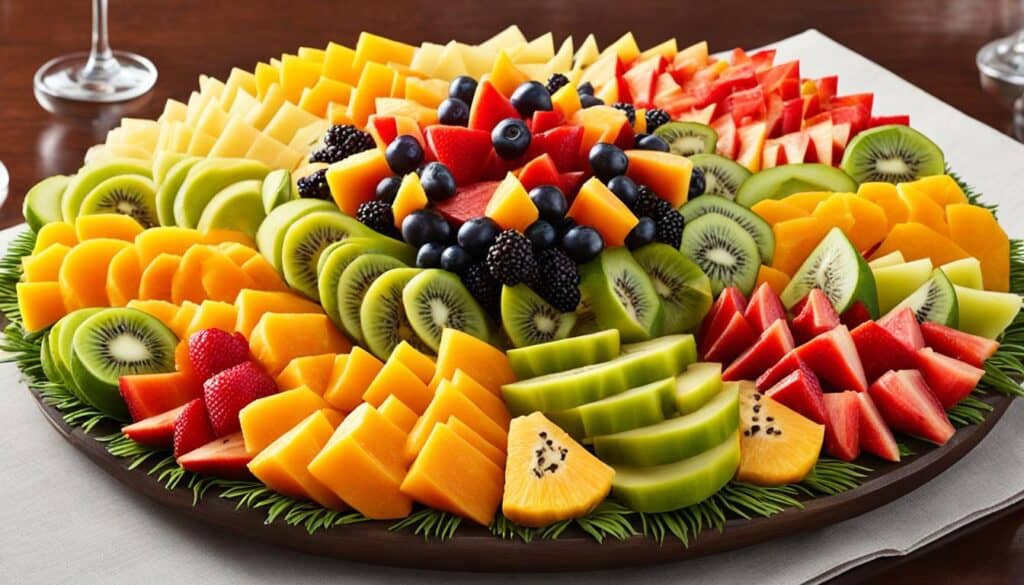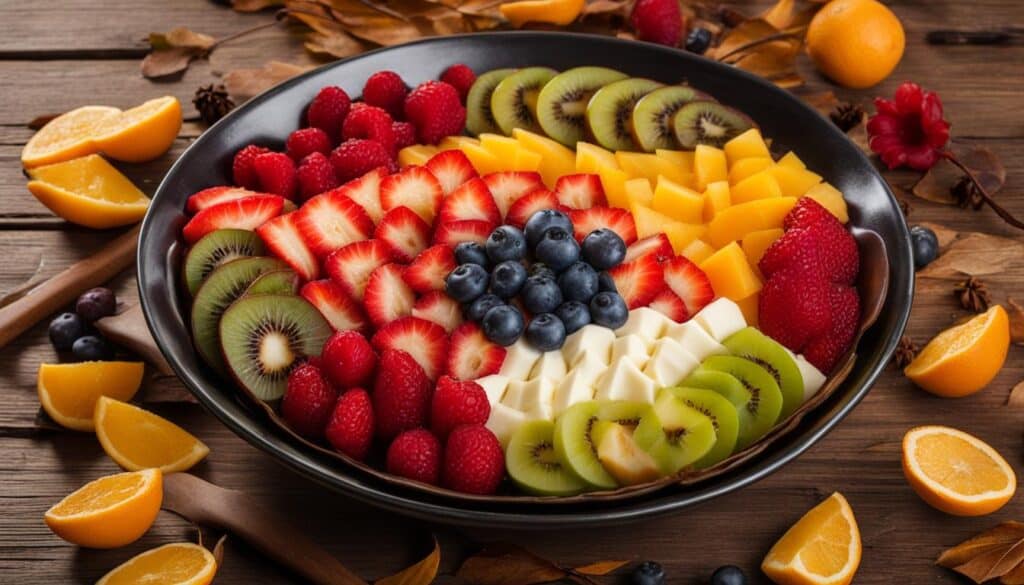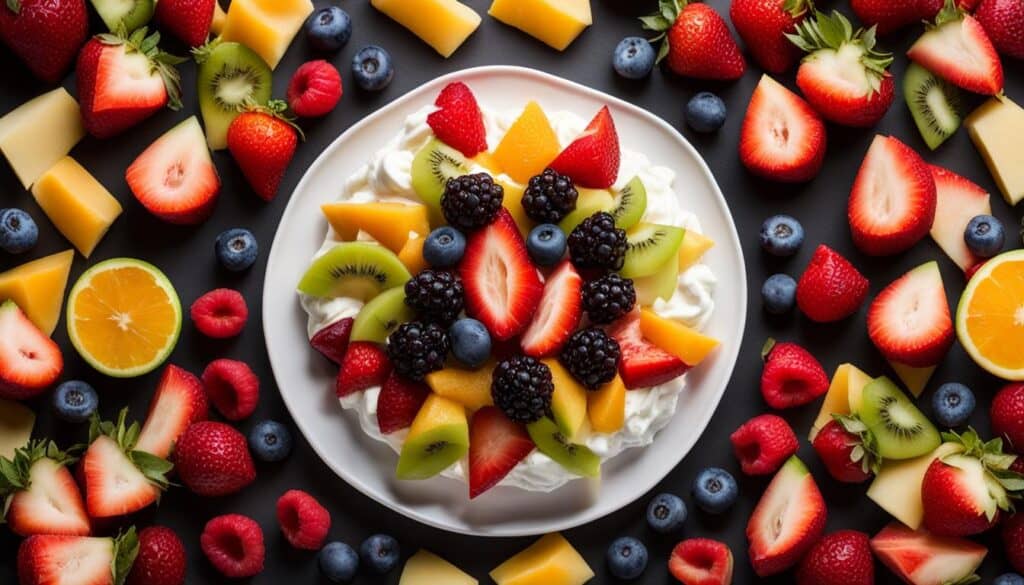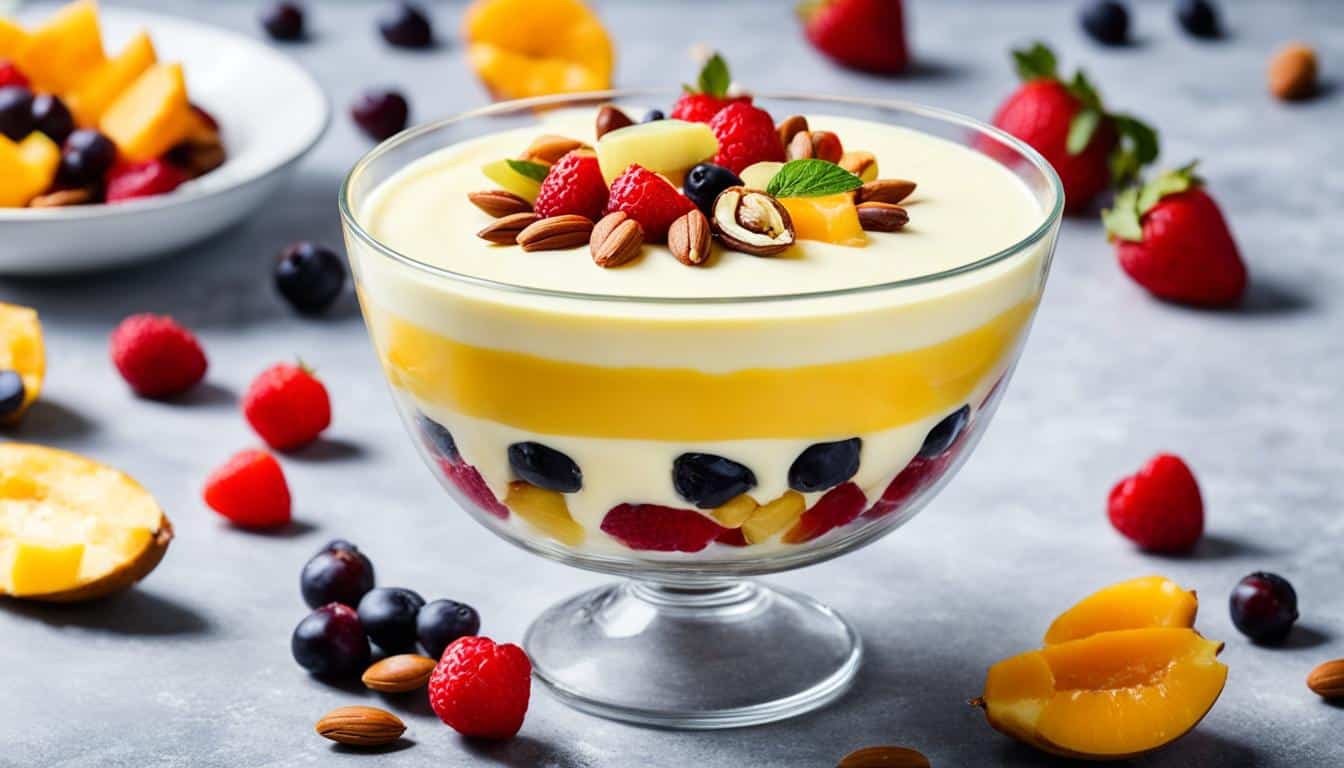When it comes to dessert, the options are endless. Cakes, cookies, ice cream, and more tempt our taste buds with their decadent sweetness. But what about fruit? Is it a dessert? This is a topic of debate among many, as some argue that fruit lacks the indulgence and richness typically associated with desserts. However, I believe that fruit can indeed be a delightful and satisfying dessert option, offering a burst of natural sweetness and a myriad of flavors.
It’s important to note that fruit can also be enjoyed as a standalone dessert. Savoring a perfectly ripe peach, biting into a juicy watermelon slice, or indulging in a handful of sweet berries can be just as satisfying as any dessert. For those with a creative flair, arranging a platter of colorful fruits can make for a visually stunning and palate-pleasing dessert experience.
Key Takeaways:
- Fruit can be a delicious and satisfying dessert option, offering natural sweetness and a variety of flavors.
- Fruit-based desserts provide essential vitamins, minerals, and antioxidants, making them a healthier choice.
- There are countless ways to incorporate fruit into your desserts, from grilling and blending to baking and arranging.
- Savoring fruit as a standalone dessert can be just as enjoyable as indulging in traditional sweet treats.
- Explore the wide range of fruits available and let your creativity shine when incorporating them into desserts.
The Definition of Fruit as a Dessert
The debate about whether fruit can be considered a dessert is ongoing. But when it comes to defining fruit as a dessert, there are a few different ways to look at it. Fruit can be enjoyed on its own as a standalone sweet treat, or it can be incorporated into a variety of dessert recipes. Fruit-based desserts offer a delicious and nutritious option for those with a sweet tooth, especially for kids.
When we think of fruit-based desserts, a few classic ideas come to mind. Fruit salads, for example, are a simple and refreshing way to enjoy a medley of fresh fruits. Whether it’s a combination of berries, tropical fruits like mango and pineapple, or a mix of melons, fruit salads can satisfy your sweet cravings while providing essential vitamins and minerals.
Another popular option is fruit parfaits. These delightful layered desserts feature a combination of fruit, yogurt or pudding, and sometimes granola or nuts for added texture. The contrasting flavors and textures create a satisfying and indulgent dessert experience.
For those who prefer warm and comforting desserts, fruit crisps and fruit pies are a delightful choice. Whether it’s a classic apple crisp or a delicious berry pie, these desserts combine the natural sweetness of fruit with a buttery or crunchy topping, creating a harmonious balance of flavors and textures.
When it comes to kids, fruit-based desserts can be an excellent way to introduce them to healthier options. By presenting fruit as a sweet treat, children are more likely to enjoy and accept it. Whether it’s a bowl of mixed berries, a fruit skewer, or a homemade fruit popsicle, these desserts can help kids develop a love for fruits while satisfying their cravings for sweets.
In conclusion, the definition of fruit as a dessert encompasses both enjoying it on its own or incorporating it into various dessert recipes. Fruit-based desserts provide a delicious, nutritious, and child-friendly option for individuals seeking a sweet treat that doesn’t compromise their health. By exploring different fruit desserts and experimenting with creative combinations, you can easily incorporate more fruits into your diet and enjoy the natural sweetness they offer.
The Nutritional Benefits of Fruit Desserts
Fruit desserts can be a delicious and nutritious way to indulge your sweet tooth. Not only do they satisfy cravings, but they also provide several nutritional benefits. Fruits are packed with essential vitamins, minerals, and antioxidants, making them a healthier option for dessert compared to traditional sugary treats. By incorporating fruit into desserts, you can enjoy a guilt-free indulgence that nourishes your body.
One of the main advantages of fruit desserts is their high nutrient content. Fruits are naturally rich in various vitamins, such as vitamin C, vitamin A, and vitamin K. These vitamins play crucial roles in supporting the overall health of your body, from boosting your immune system to promoting healthy skin. By including fruits in your desserts, you can effortlessly increase your vitamin intake.
In addition to vitamins, fruits are also abundant in minerals, including potassium, magnesium, and folate. These minerals are essential for maintaining healthy bodily functions, such as regulating blood pressure, promoting bone health, and supporting red blood cell production. Incorporating fruits into your desserts allows you to benefit from these vital minerals while enjoying a delectable treat.
Furthermore, fruits are powerful sources of antioxidants. Antioxidants help protect your body against harmful free radicals, reducing the risk of chronic diseases like heart disease and certain types of cancer. By including antioxidant-rich fruits in your desserts, you can take a proactive approach to your health and wellbeing.
Another advantage of fruit desserts is that they are generally lower in calories and fat compared to traditional desserts. Fruits are naturally low in calories while providing natural sweetness, allowing you to satisfy your sweet cravings without the guilt. Moreover, fruits are low in saturated fat and cholesterol, making them an excellent choice for those looking for healthier dessert options.
When it comes to using fruit in desserts, the possibilities are endless. From classic fruit salads to more elaborate fruit tarts or parfaits, there are numerous ways to incorporate fruit into your sweet treats. You can mix different fruits together to create a vibrant and refreshing dessert, or you can opt for a simple fruit-based smoothie for a quick and nutritious indulgence.
| Fruit Dessert Nutritional Comparison | Calories (per serving) | Total Fat (g) | Saturated Fat (g) |
|---|---|---|---|
| Fruit Salad | 80 | 0 | 0 |
| Apple Pie | 320 | 12 | 6 |
| Strawberry Shortcake | 290 | 10 | 6 |
| Banana Split | 420 | 17 | 10 |
As shown in the table above, fruit desserts generally have fewer calories and lower fat content compared to traditional desserts like apple pie or strawberry shortcake. This makes them an excellent choice for those who want to enjoy a dessert while maintaining a balanced diet.
Creative Ways to Use Fruit in Desserts
When it comes to fruit-based desserts, the possibilities are endless. You can unleash your creativity and experiment with various techniques to elevate the flavor and presentation of your sweet treats. Incorporating fruit into desserts not only adds a natural sweetness but also introduces an array of vibrant colors and refreshing textures. Here are some creative ideas to inspire your fruit dessert recipes:
Grilled Fruit for Caramelized Delights
Elevate the flavor profile of your fruit-based desserts by grilling the fruits. Grilling imparts a delightful caramelized taste and brings out the natural sweetness of fruits like pineapple, peaches, and watermelon. Serve the grilled fruits on their own or use them as toppings for ice cream, yogurt, or cakes. The smoky and slightly charred flavors will add a delicious twist to your desserts.
Blending Fruits into Smoothies and Sorbets
Blend a variety of fresh fruits to create refreshing smoothies or sorbets. Experiment with different flavor combinations such as strawberry-banana, mango-pineapple, or mixed berry. You can also add a handful of spinach or kale for an extra health boost. These fruity concoctions make for a nutritious and satisfying dessert option, especially during hot summer days.
Fruit-Infused Cakes and Cupcakes
Take your cakes and cupcakes to the next level by incorporating fruit into the batter or as fillings. Whether it’s adding blueberries to a lemon cake, diced apples to a cinnamon-spiced cake, or mashed bananas to a chocolate cake, fruit adds moisture, natural sweetness, and a burst of flavor. The result is a delightful dessert that strikes the perfect balance between richness and fruity freshness.
Fruit-Based Popsicles and Ice Cream
Cool down with homemade fruit-based popsicles or indulge in creamy fruit-flavored ice cream. Use fruit purees or finely chopped fruits mixed with yogurt or coconut milk as the base for your frozen treats. You can experiment with different fruit combinations or focus on a single fruit flavor like strawberry, mango, or raspberry. These icy desserts are not only refreshing but also a delightful way to enjoy the natural taste of fruits.
Incorporating fruit into desserts opens up a world of delicious possibilities. Whether you’re grilling, blending, baking, or freezing, the sweet and tangy flavors of fruits can transform any dessert into a tantalizing treat. So, get creative in the kitchen and let your imagination run wild with these fruit dessert ideas.
Fruit as a Component of Desserts in History
Fruit has played a significant role in desserts throughout history, with various cultures and civilizations incorporating it into their culinary traditions. From ancient times to the present day, fruit-based desserts have delighted taste buds and satisfied sweet cravings.
Ancient civilizations like the Romans recognized the energy-boosting properties of fruit and cleverly used it to create fruitcakes. These early fruitcakes served as portable snacks, providing a burst of sweetness and nutrition during long journeys and battles.
Throughout Europe, fruitcakes have been enjoyed for centuries, gaining popularity in different variations like stollen and panettone. The combination of dried and candied fruits, spices, and a dense cake base made fruitcakes a cherished treat, especially during festive occasions.
In America, fruitcakes became a holiday staple, with their rich flavors and long shelf life making them an ideal dessert choice. Families would eagerly exchange fruitcakes as gifts, savoring the sweet and fruity goodness during the festive season.
“Fruitcakes are a classic example of how fruit has been cherished in desserts throughout history. These decadent treats embody the warmth and nostalgia associated with traditional desserts.”

| Fruit-Based Dessert | Origin | Description |
|---|---|---|
| Fruitcake | Worldwide | A rich cake filled with a mix of dried and candied fruits, nuts, and spices. It is often enjoyed during festive occasions. |
| Stollen | Germany | A traditional German fruitcake with marzipan, raisins, and candied citrus peel. It is dusted with powdered sugar and enjoyed during Christmas. |
| Panettone | Italy | An Italian sweet bread loaf studded with candied fruits. It is typically consumed during the holiday season. |
Key Takeaways:
- Fruitcakes have been enjoyed throughout history as a delicious and long-lasting dessert option.
- European variations like stollen and panettone have their unique flavor profiles and cultural significance.
- Americans have embraced fruitcakes as a traditional holiday treat.
- Fruitcakes often include a combination of dried and candied fruits, nuts, and spices.
Exploring the history and cultural significance of fruit-based desserts can inspire new ideas and innovations in the world of sweets. It’s fascinating to see how fruit has evolved and endured as a component of desserts, bringing joy and satisfaction to people’s palates for centuries.
The Cultural Variations of Fruit as a Dessert
Different cultures around the world have their unique variations of fruit as a dessert. From Europe to Asia to Latin America, fruit-based desserts are celebrated and enjoyed in different ways.
Europe
In Europe, fruit tarts, pies, and strudels are common dessert choices. These delectable treats showcase the region’s love for fruit-based desserts and highlight the use of seasonal fruits.
Asia
In Asia, fresh fruit platters and fruit-based desserts are popular. One of the most beloved Asian desserts is mango sticky rice, a delicious combination of ripe mangoes, sticky rice, and coconut milk. This sweet and fragrant treat is often enjoyed during the summer months when mangoes are in season.
Latin America
Latin American cuisine is known for its vibrant flavors, and tropical fruits like pineapple and mango play a prominent role in their desserts. These fruits are often enjoyed as a sweet treat on their own or incorporated into traditional desserts like fruit salads or fruit popsicles.
Exploring the cultural variations of fruit as a dessert can inspire you to try new and exciting fruit-based desserts from around the world. Whether you’re indulging in a classic European fruit tart, savoring the sweetness of Asian-inspired mango sticky rice, or enjoying a refreshing tropical fruit treat from Latin America, fruit desserts offer a delightful way to satisfy your sweet cravings.

| Region | Popular Fruit-based Desserts |
|---|---|
| Europe | Fruit tarts, pies, strudels |
| Asia | Mango sticky rice, fruit platters |
| Latin America | Pineapple and mango desserts, fruit salads, fruit popsicles |
Incorporating Fruit into Everyday Meals
Fruit can be a delightful addition to your everyday meals, providing a touch of natural sweetness and a boost of nutrition. By incorporating fruit into breakfast, lunch, or dinner, you can enjoy its delicious flavors while reaping the health benefits it offers. Here are some simple and creative ways to include fruit in your daily meals:
1. Breakfast Boost
Start your day off right by adding fruit to your breakfast routine. Sprinkle berries like strawberries, blueberries, or raspberries over your morning yogurt or cereal for a burst of freshness. The vibrant colors and juicy texture of the fruits will make your breakfast not only tastier but also visually appealing.
2. Pancake & Waffle Delight
Elevate your pancake or waffle game by topping them with sliced fruit. Whether it’s bananas, peaches, or even sliced apples, the natural sweetness of the fruit will complement the fluffy pancakes or crispy waffles. You can also drizzle a bit of honey or maple syrup for an extra touch of indulgence.
3. Side Dish Surprise
Instead of traditional sides like french fries or mashed potatoes, consider incorporating a fruit salad as a refreshing side dish with your lunch or dinner. A colorful mix of fruits, such as watermelon, pineapple, and grapes, will not only add a touch of sweetness to your meal but also provide a dose of vitamins and hydration.
Here’s a quick recipe for a refreshing fruit salad:
| Ingredients: | Instructions: |
|---|---|
|
|
4. Fruit Infused Water
Stay hydrated and add a hint of flavor to your water by infusing it with fruits. Simply cut up your favorite fruits, such as oranges, lemons, or berries, and add them to a pitcher of water. Let the flavors infuse for a few hours in the refrigerator before enjoying a refreshing and flavorful drink that will help you stay hydrated throughout the day.
Remember, incorporating fruit into your everyday meals not only adds a naturally sweet touch but also increases your intake of essential vitamins, minerals, and fiber. So get creative and experiment with different fruits to find new and exciting ways to enjoy them with your meals.

The Versatility of Fruit as a Dessert Ingredient
Fruit is a remarkably versatile ingredient that can elevate any dessert to a whole new level. Its natural sweetness and vibrant flavors make it a delicious addition to a wide variety of dessert recipes. Whether blended into refreshing smoothies, baked into delectable pies or tarts, layered in luscious parfaits, or even grilled for a tantalizing caramelized flavor, fruit brings a burst of freshness and a touch of healthy indulgence to any sweet treat.
Not only does fruit enhance the taste of desserts, but it also adds a pop of color and visual appeal. The bright hues of ripe berries, succulent peaches, and tangy citrus fruits create an enticing feast for the eyes. Plus, the nutritional benefits of fruit can make your dessert a guilt-free pleasure.
- Whip up a refreshing fruit salad, combining an array of seasonal fruits like juicy watermelon, crisp apples, and succulent grapes. Add a drizzle of honey and a sprinkle of fresh mint leaves for an extra touch of flavor.
- Indulge in a velvety fruit smoothie by blending your favorite fruits with yogurt or milk. The possibilities are endless, from classic combinations like strawberry and banana to exotic blends like mango and pineapple.
- Bake a heavenly fruit tart, using a buttery crust as a canvas for showcasing an assortment of ripe, juicy fruits. Arrange slices of peaches, plums, and berries on top, dust with powdered sugar, and serve with a dollop of whipped cream.
- Layer a tempting fruit parfait with alternating spoonfuls of creamy yogurt, crunchy granola, and a medley of fresh fruits. The delightful combination of textures and flavors will leave you craving for more.
- Fire up the grill and savor the delightful smokiness of grilled fruit. Pineapple, peaches, and figs are particularly great choices. Serve them with a scoop of vanilla ice cream or a drizzle of honey for a simple yet sophisticated dessert.
The possibilities of using fruit in desserts are truly endless. Get creative, experiment with different fruit combinations, and let your taste buds guide you. By incorporating fruit into your desserts, you can indulge in sweet treats while also nourishing your body with the goodness of nature.

Now that we’ve explored the versatility of fruit as a dessert ingredient, let’s delve into the rich history of fruit as a component of desserts in Section 9.
Conclusion
Fruit can definitely be enjoyed as a dessert, whether on its own or as part of a delicious recipe. It offers natural sweetness, a wide range of flavors, and nutritional benefits that make it a fantastic choice for satisfying your sweet tooth. Whether you’re looking for fruit desserts for kids or searching for fruit dessert recipes, the possibilities are endless.
By exploring different fruit-based desserts, you can discover new and exciting ways to incorporate fruit into your meals. From fruit salads to parfaits, pies to popsicles, there are countless options to indulge in a satisfying and healthier dessert experience.
Remember, though, to enjoy fruit in moderation as part of a balanced diet. Incorporating fruit into your everyday meals can help increase your fruit consumption and add a touch of sweetness to your favorite dishes. So, go ahead, get creative, and savor the natural goodness of fruit in your desserts!
FAQ
Is fruit considered a dessert?
Some people debate whether fruit can be considered a dessert. However, fruit can be enjoyed as a standalone sweet treat or incorporated into a dessert recipe.
What are some fruit-based desserts?
Fruit-based desserts can include fruit salads, fruit parfaits, fruit crisps, and fruit pies.
Are fruit desserts a healthy option?
Yes, fruit desserts can be a nutritious option, especially for children. Fruits are rich in vitamins, minerals, and antioxidants, making them a healthier alternative to traditional desserts.
How can I use fruit in desserts?
There are countless creative ways to use fruit in desserts such as grilling fruit, blending fruit into smoothies or sorbets, incorporating fruit into cakes or cupcakes, and making fruit-based popsicles or ice cream.
What is the historical significance of fruit in desserts?
Fruit has been used as a component of desserts throughout history. Ancient civilizations made fruitcakes as energy bars, and fruitcakes have been popular in different variations like stollen and panettone in Europe.
Do different cultures have unique fruit-based desserts?
Yes, different cultures around the world have their own variations of fruit as a dessert. In Europe, fruit tarts, pies, and strudels are common. In Asia, fresh fruit platters or fruit-based desserts like mango sticky rice are popular. In Latin America, tropical fruits like pineapple and mango are often enjoyed as a sweet treat.
How can I incorporate fruit into everyday meals?
Fruit can be added to everyday meals as a sweet touch. For example, adding berries to yogurt or cereal, topping pancakes or waffles with sliced fruit, or enjoying a fruit salad as a side dish with lunch or dinner.
How versatile is fruit as a dessert ingredient?
Fruit is a versatile ingredient that can be blended into smoothies, baked into pies or tarts, layered in parfaits, or grilled for a caramelized flavor. The natural sweetness and variety of flavors in different fruits make them a versatile and delicious addition to desserts.
Can fruit be considered a dessert?
Fruit can certainly be enjoyed as a dessert, whether as a standalone treat or incorporated into dessert recipes. It provides natural sweetness, nutritional benefits, and a wide range of flavors.





Leave a Reply